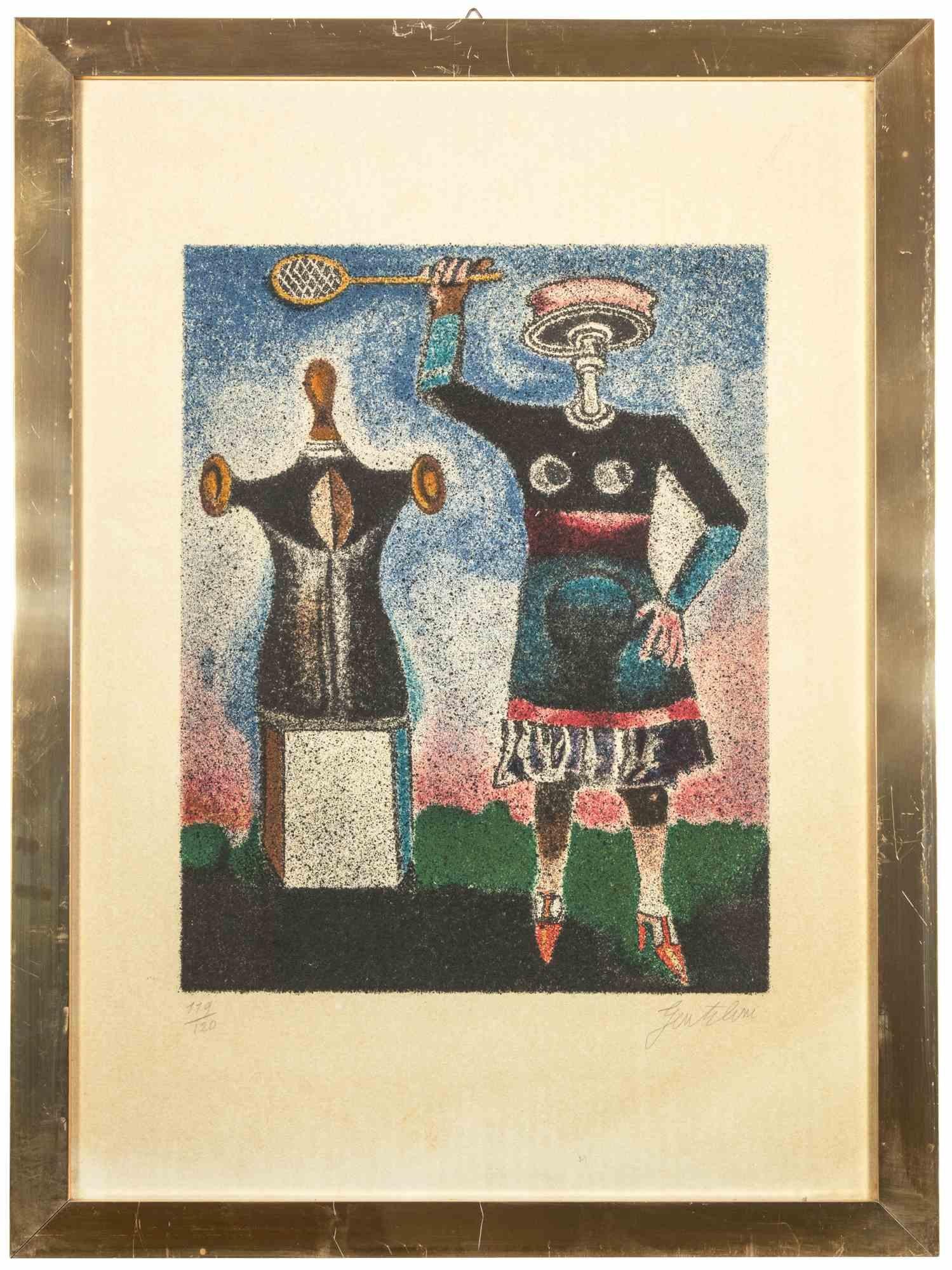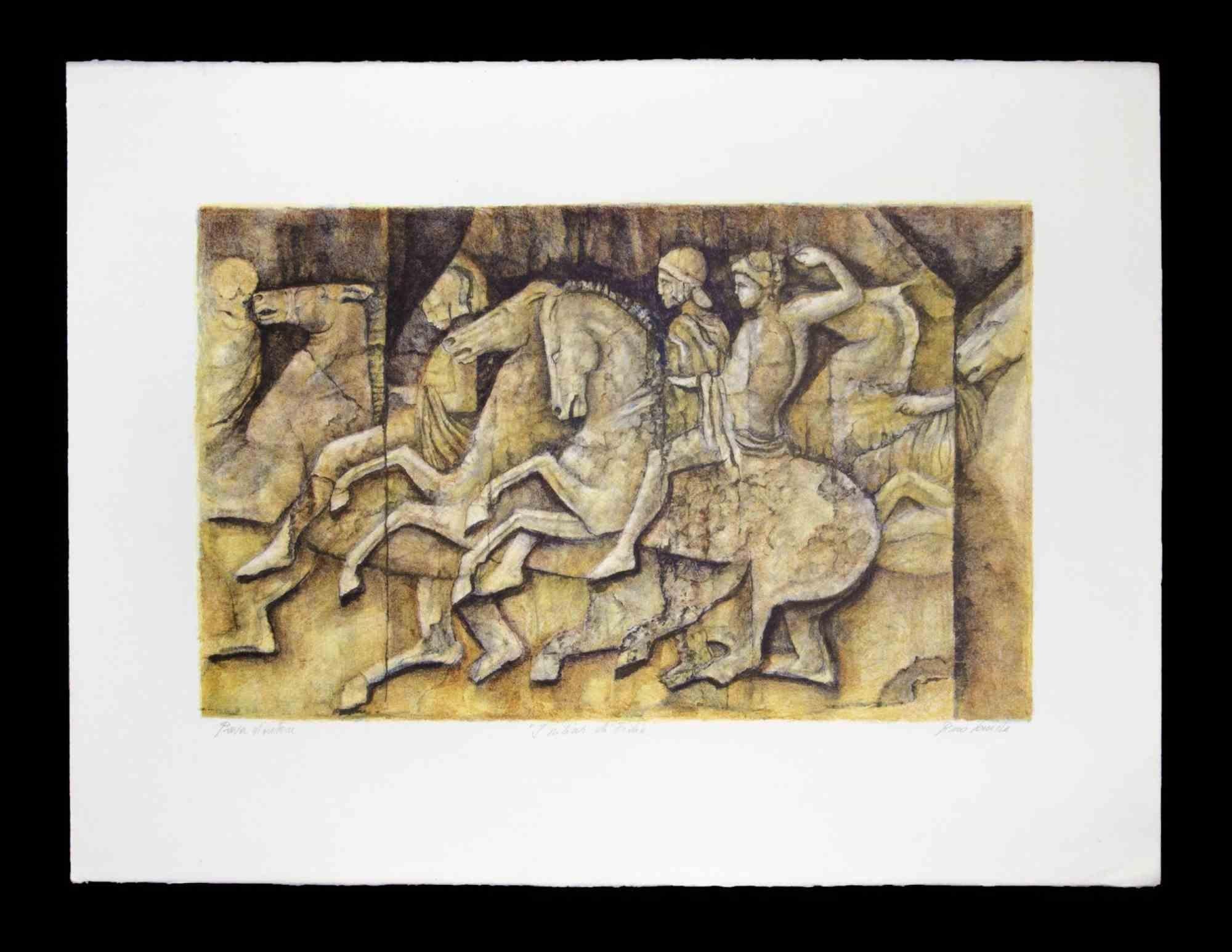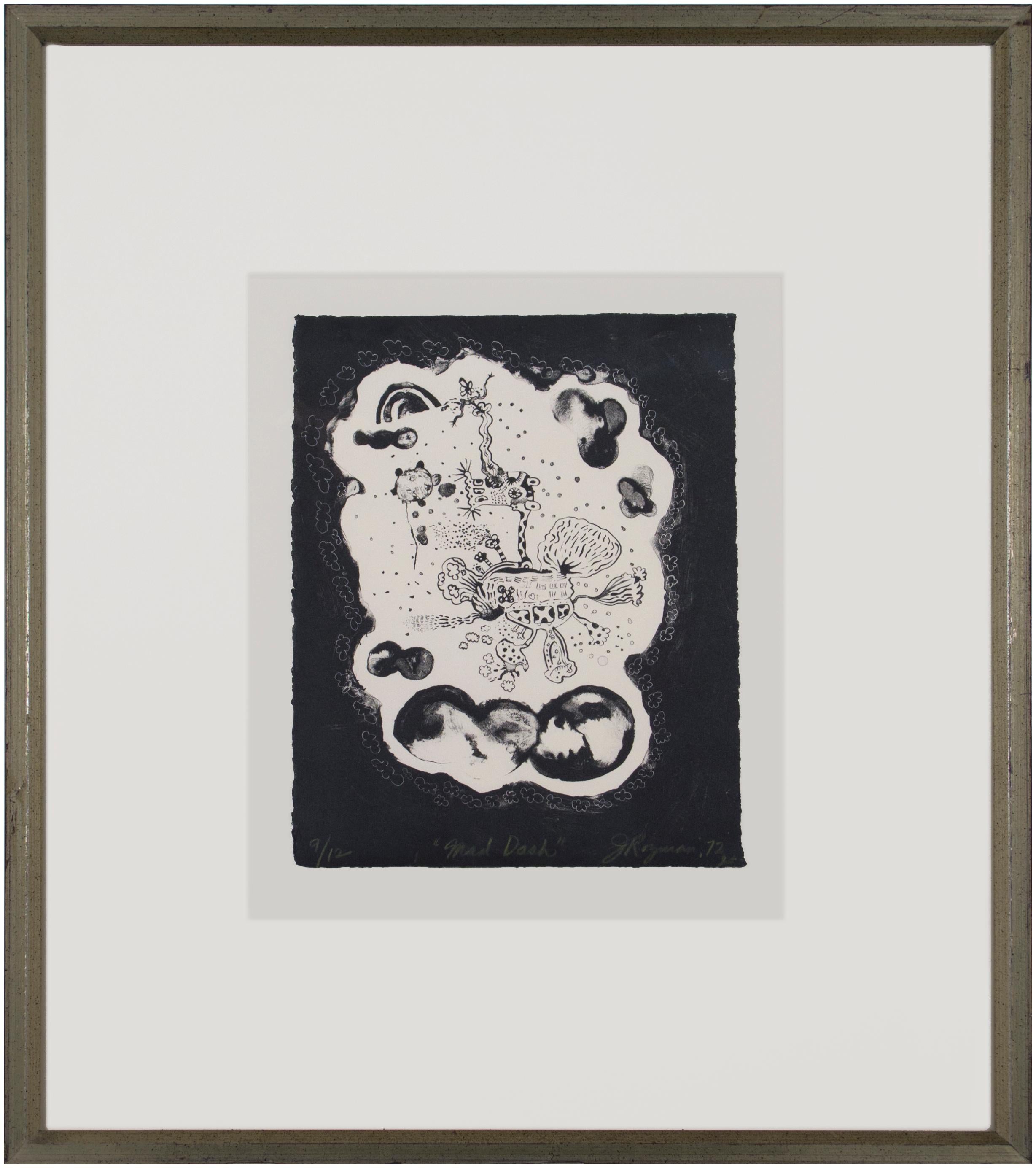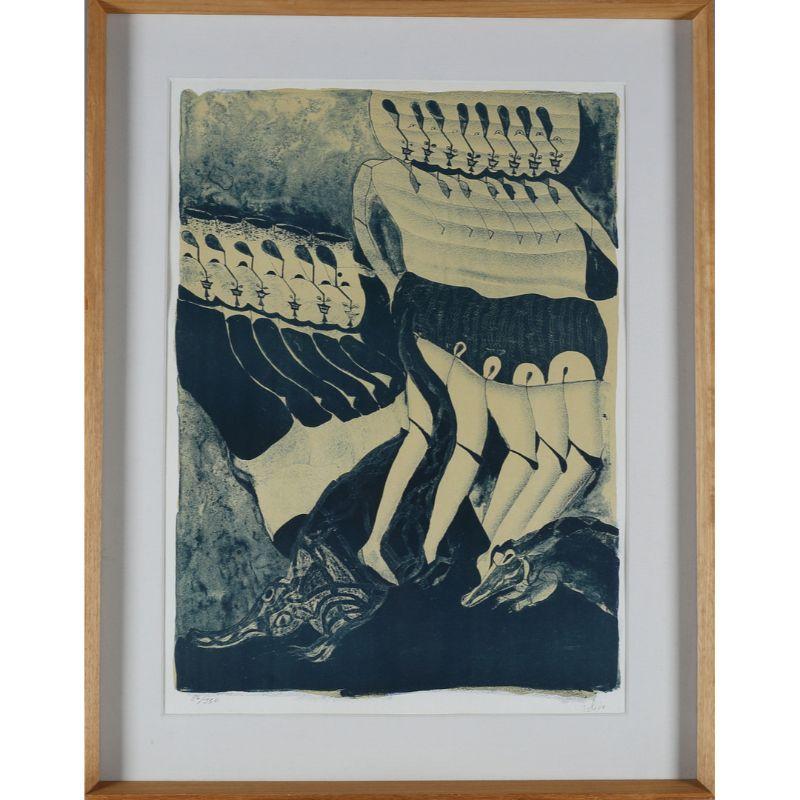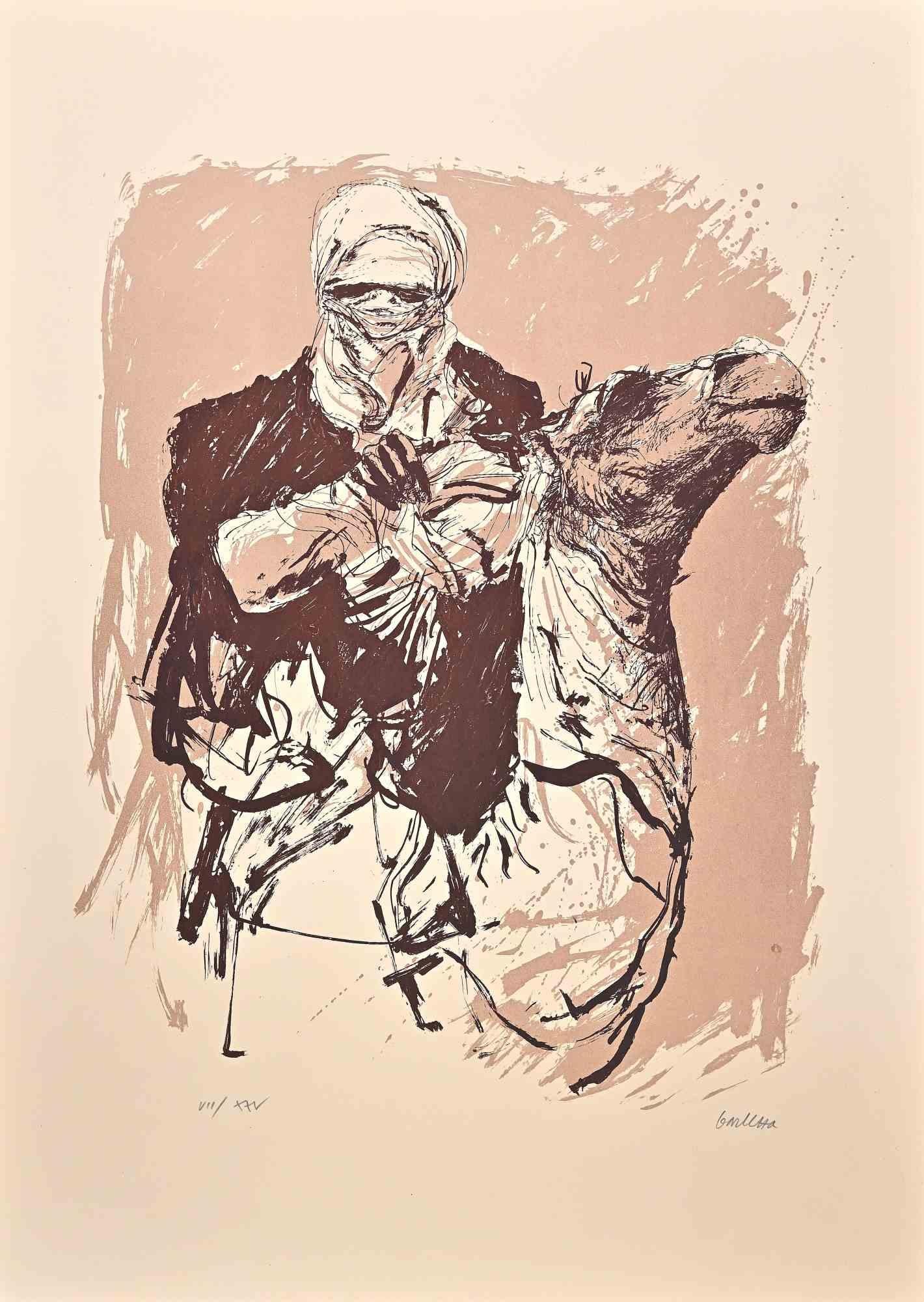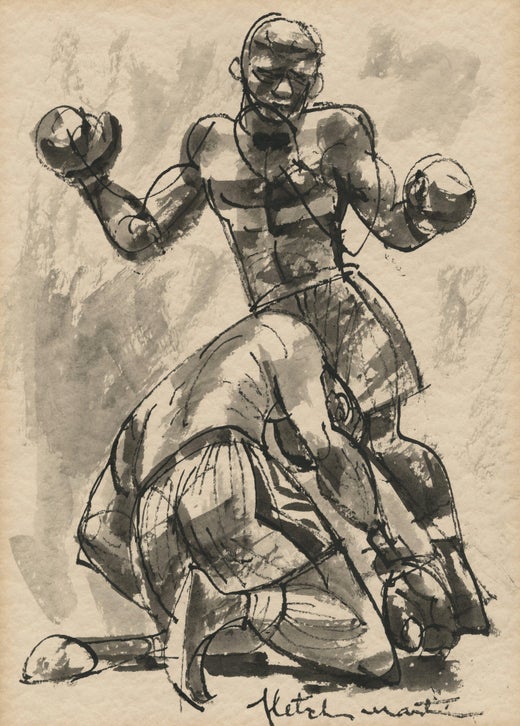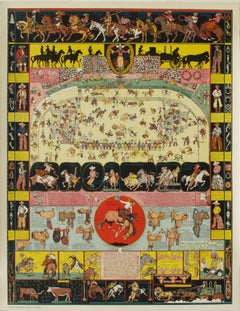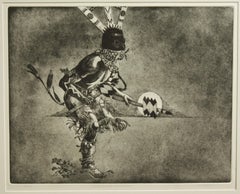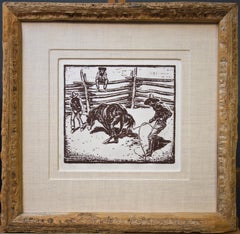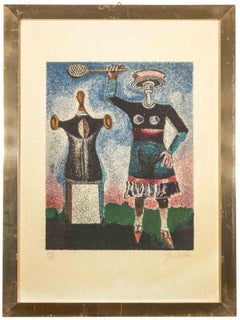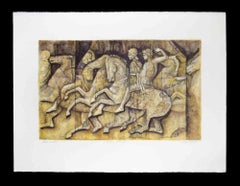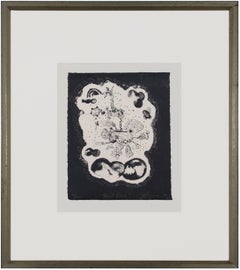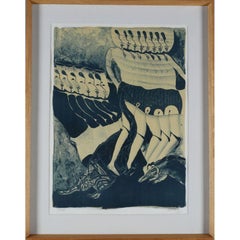Items Similar to High Wide and Handsome by Fletcher Martin 1953, Original Stone Lithograph
Want more images or videos?
Request additional images or videos from the seller
1 of 6
Fletcher MartinHigh Wide and Handsome by Fletcher Martin 1953, Original Stone Lithograph1953
1953
$1,850
£1,411.05
€1,606.85
CA$2,599.81
A$2,835.46
CHF 1,502.04
MX$33,993.17
NOK 19,129.27
SEK 17,492.30
DKK 12,004.72
About the Item
SHIPPING CHARGES INCLUDE SHIPPING, PACKAGING & **INSURANCE**
Fletcher Martin
Size: 16 x12 inches
Stone lithograph
Frame 25 x 21 inches
High, Wide and Handsome- - 1953, Lithograph.
Edition 250. Signed in pencil.
Shipping is included
Image size 12 3/4 x 8 3/4 inches (325 x 222 mm); sheet size 16 x 12 inches (406 x 305 mm).
Original hand carved frame by Michael Collier. WPA period design with hand applied French lines, museum standards for framing materials.
FLETCHER MARTIN (1904-1979)
Fletcher Martin was born in Colorado in 1904 the son of a newspaperman. 1922 he joined the U.S. Navy and served as a seaman for four years, after which he moved to Los Angeles Calif. and became a printer and there began to teach himself art studying briefly with the painter, Foujita. He began in the early thirties, during the Depression, to show in Los Angeles at the Dalzell Hatfield Galleries. He studied mural painting with the legendary Siqueiros. He became a WPA artist painting murals at North Hollywood High, San Pedro Federal Building and post offices in Idaho, Texas and California. During his "out west" period he painted Western scenes such as cowboys, broncos and steers. Prize fighters and horse racing are also major subject matters of Martin throughout his life. He moved to Woodstock, N. Y. in 1947 where he lived and painted until he died in 1979. His work is in hundred of collections both private and institutional, among them being the Museum of Modern Art, Los Angeles Museum of Fine Art and the Smithsonian. He has shown at the Midtown Gallery, Rudolph Gallery, Kansas City Art Institute, University of Iowa, Woodstock Artists Association and the Metropolitan Museum of Art
Illustrated in Fletcher Martin, by H. Lester Cooke, New York, Harry N. Abrams, 1977; American Prints in the Library of Congress, The John Hopkins Press, Baltimore, 1970. Collection: LC purchase, Pennell Fund.
- Creator:Fletcher Martin (1904-1979, American)
- Creation Year:1953
- Dimensions:Height: 16 in (40.64 cm)Width: 12 in (30.48 cm)
- Medium:
- Movement & Style:
- Period:
- Condition:
- Gallery Location:Phoenix, AZ
- Reference Number:1stDibs: LU2623215179172
Fletcher Martin
Fletcher Martin was an American painter, illustrator, muralist and educator. He is best known for his images of military life during World War II and his sometimes brutal images of boxing and other sports. Martin was born in 1904 in Palisade, Colorado, one of seven children of newspaperman Clinton Martin and his wife Josephine. The family relocated to Idaho and later Washington. By the age of 12, he was working as a printer. He dropped out of high school and held odd jobs such as lumberjack and professional boxer. He served in the U.S. Navy, 1922–26. Martin's artistic skills were largely self-taught.
About the Seller
No Reviews Yet
Vetted Professional Seller
Every seller passes strict standards for authenticity and reliability
1stDibs seller since 2023
8 sales on 1stDibs
- ShippingRetrieving quote...Shipping from: Phoenix, AZ
- Return Policy
More From This Seller
View AllJo Mora, Evolution of the Cowboy 1933, from Jo Mora Estate
Located in Phoenix, AZ
"LAST ONE IN MINT CONDITION"
Evolution of the Cowboy, 1933
Original Lithograph
Excellent condition, came directly from Jo Mora Jr.
Unframed!!
SHIPPING CHARGES INCLUDE SHIPPING, PACKAGING & INSURANCE
Original version was called Evolution of the Cowboy, 1933 or referred today as "Sweetheart of the Rodeo", Images from the poster were used for "Sweetheart of the Rodeo", the sixth album by American rock band the Byrds and was released on August 30, 1968. It was hated when released, today it is considered one of the great classics.
This is an original lithograph from the Jo Mora Estate from Jo Mora Jr.
Joseph Jacinto Mora (October 22, 1876 – October 10, 1947) was a Uruguayan-born American cowboy, photographer, artist, cartoonist, illustrator, painter, muralist, sculptor, and historian who wrote about his experiences in California. He has been called the "Renaissance Man of the West".
Early life
Mora was born on October 22, 1876, in Montevideo, Uruguay. His father was the Catalan sculptor, Domingo Mora, and his mother was Laura Gaillard Mora, an intellectual born in the Bordeaux region of France. His elder brother was F. Luis Mora, who would become an artist and the first Hispanic member of the National Academy of Design. The family entered the United States in 1880 and first settled in New York City, and then Perth Amboy, New Jersey.
Jo Mora 1931 Yosemite map
Jo Mora studied art at the Art Students League of New York and the Cowles Art School in Boston. He also studied with William Merritt Chase. He worked as a cartoonist for the Boston Evening Traveller, and later, the Boston Herald.
In the spring of 1903, Mora arrived in Solvang, California. He stayed at the Donohue Ranch. He made plans to travel to the Southwest to paint and photograph the Hopi. He spent time at the Mission Santa Inés; those photographs are now maintained by the Smithsonian Institution. Mora visited many Spanish missions in California that summer by horseback. He followed the "Mission Trail", also called the "Kings Highway".
In 1904, Mora visited Yosemite. Later, in 1904, to 1906, visited Arizona where he took photographs, painted and otherwise recorded the daily life of these Native Americans. Because the Hopi and other tribes have voiced their concerns more recently about photographs depicting religious ceremonies, the tribal nation should be contacted before they are used. He learned the Native languages and made detailed drawings of what he observed.
Career
In 1907, Mora wrote and illustrated the comic strip Animaldom.
In 1907, Mora returned to California and married Grace Needham. Their son, Joseph Needham Mora, was born on March 8, 1908. The Moras moved to San Jose, California, where Mora continued his work.
On 22 February 1911, the Native Sons of the Golden West Building, in San Francisco, with six terra cotta panels, by Domingo Mora and his son, Jo Mora, was dedicated.
In 1915, he served on the International Jury of Awards at the Panama–Pacific International Exposition and displayed six sculptures.[9]
In 1915-16 two of his sculptural commissions were revealed: the bronze memorial tablet with the profile of the late Archbishop Patrick W. Riordan for the Knights of Columbus and the Cervantes Monument in San Francisco's Golden Gate Park.[10][11] By 1919, he was sculpting for the Bohemian Club, including the Bret Harte Memorial plaque, completed in August 1919 and mounted on the outside of the private men's club building in San Francisco.
Carmel-by-the-Sea
In 1921, the Mora family relocated to Carmel-by-the-Sea, California, the largest art colony on the West Coast, making it their primary residence. He constructed a Craftsman-style home, which is located on the west side of San Carlos Street, the third house south of 1st Avenue.
Mora received a commission for the bronze and travertine Cenotaph, for Father Junípero Serra in the Memorial Chapel at the west end of Mission Carmel.
Mora was a director of the Carmel Art Association as early as 1934. His sculptures were exhibited between 1927 and 1934 in various galleries in Carmel.
Jo Mora is a serious sculptor, a responsible amateur actor; when mixed up with pen and ink, a humorist! Comic strips was once his trade. He was famous at it. That was years ago but his art of cartooning bloomed again when in recent years he produced the well known Mora Map of the Monterey Peninsula. Most successful with bronze statue creations which decorate many gardens in East and West. If he has a specialty in figures it is cowboys. He knows his West. Jo Mora will ever be famed for his portrayal of Pancho Lopez, The Bad Man, at Carmel Playhouse. He does everything well and is handsome while doing it. He is happily married-alas!
— Carmel Pine Cone
During the Great Depression, Mora created the "Carmel Dollar" as part of Carmel's program, offering unemployed residents scrip for public service, exchangeable for groceries and essentials; a three-cent stamp on the certificate's back acknowledged their efforts. When full, merchants accepted the certified scrip for goods or a dollar.
Architect Robert Stanton...
Category
1930s Other Art Style More Prints
Materials
Lithograph
Apache Mountain Spirit Dancer
Located in Phoenix, AZ
SHIPPING CHARGES INCLUDE SHIPPING, PACKAGING & **INSURANCE**
Apache Mountain Spirit Dancer
James Rome
Etching 62/100
Image: 21.75 x 27.5 inches
Paper: 25 x...
Category
1980s Contemporary Figurative Prints
Materials
Etching
Bronc by Lon Megargee, Woodblock Print ca. 1920s with Handmade Saguaro Rib Frame
Located in Phoenix, AZ
SHIPPING CHARGES INCLUDE SHIPPING, PACKAGING & **INSURANCE**
Bronc by Lon Megargee, Woodblock Print ca. 1920s
Handmade Saguaro Rib Frame, double linen mat, museum archival materials
Bronc
Woodblock Print, signed in print
Image: 8 3/4 x 9 7/8 inches
Frame: 21 x 20 inches
SHIPPING CHARGES INCLUDES, SHIPPING, PACKAGING & INSURANCE
FINE ART ESTATE OF LON MEGARGEE
Megargee Custom Handmade Saguaro Frame
We offer signed in print and original signature block prints. Custom, hand carved, signature frames, with archival standards and a speciality in hand dyed mats and french matting are provided for a beautiful and timeless presentation.
Free shipping Continental US
Biography
Megargee explored different mediums; printmaking captivated him in particular. The contrast of the black and white block print method captured perfectly his interpretation of a bold American West. The first print was produced around 1921 and culminated with the creation of “The Cowboy Builds a Loop” in 1933 with 28 images and poetry by his friend, Roy George. Megargee continued producing prints throughout the 1940s and early 50s.
Creator of the iconic logo for the Stetson Hat Company, " Last Drop From his Stetson", still in use today.
Fine Art Estate of Lon Megargee
At age 13, Lon Megargee came to Phoenix in 1896 following the death of his father in Philadelphia. For several years he resided with relatives while working at an uncle’s dairy farm and at odd jobs. He returned to Philadelphia in 1898 – 1899 in order to attend drawing classes at the Pennsylvania Academy of the Fine Arts. Back in Phoenix in 1899, he decided at the age of 16 to try to make his living as a cowboy. Lon moved to the cow country of Wickenburg where he was hired by Tex Singleton’s Bull Ranch. He later joined the Three Bar Ranch . . . and, after a few years, was offered a job by Billy Cook...
Category
Early 20th Century Figurative Prints
Materials
Woodcut
Misfit by Greg Singley
Located in Phoenix, AZ
Title: Misfit
Artist: Greg Singley
Signed original signature
Archival Pigment Print,
100% Rag Paper 300 gm
Paper size: 24 x34 inches
Image Size: 20 x 30 inches
Greg Singley
Greg Singley – was born in 1950 in Greensboro, Alabama. He received his Associates Degree at Walker Collage Jasper Alabama and furthered his college education at the University of South Alabama, Mobile Alabama. He attended the revered Ringling School of Art for his art training in Sarasota Florida and graduated with honors with a certificate in commercial illustration.
In 1978 Singley moved to Phoenix Arizona to pursue his passion for western art and illustration. He worked for several years as an art director for Phoenix Public News and as a freelance illustrator and at the same time experienced sales of Native American and Western Landscape in several Arizona galleries which include Ratliff Williams Gallery, Sedona Arizona, Fagan Peterson Fine Art, Scottsdale and the Dan May Gallery, Scottsdale Arizona.
After a foray into freelance illustration Singley sought representation for his varied abilities and interest in fine art and found the Phoenix Art Group...
Category
2010s Contemporary Figurative Prints
Materials
Archival Pigment
Painted Lodge by Greg Singley
Located in Phoenix, AZ
Greg Singley , born 1950-
Artist Statement:
When the sun sets in the desert South West, things appear. This is the nature of what touches me about that la...
Category
2010s Contemporary Figurative Paintings
Materials
Oil
Indians of North America 1936 by Jo Mora
Located in Phoenix, AZ
Indians of North America 1936
Jo Mora
Lithograph
Paper size: 31 7/8 x 24 1/4 inches
Image size; 30 1/4 x 22 7/8 inches
These are the original lithographs from the Jo Mora Estate from Jo Mora Jr.
THESE ARE NOT REPRODUCTIONS!
SHIPPING CHARGES INCLUDE SHIPPING, PACKAGING & INSURANCE
Joseph Jacinto Mora 1876 – 1947
Mora was born in Montevideo, Uruguay, and was the son of Domingo Mora, a well-known painter and sculptor who brought his family to the United States in the mid 1890s and then became a teacher in New York at the Art Students League. Joseph and his artist brother Luis Mora (1874-1940) grew up being much influenced by the creative atmosphere of their father’s studio. In 1904, he returned to Arizona and New Mexico and lived with Hopi and Navajo tribes, learning their languages and painting depictions of their ceremonies, especially the Kachina ceremonial dances. One of the results of his Western travels was a series of humorous maps that were spoofs of the national parks and that were made into posters. In the 1930s, the maps sold for 25 cents each and were distributed through souvenir shops at the parks. He also painted a watercolor series, “Horsemen of the West” and wrote two books, “Trail Dust and Saddle Leather” and “Californios.” Joseph Mora died in Pebble Beach on October 10, 1947. Devoting his life to exploration of subjects as diverse as vaqueros, Hopi Kachina figures, the Arizona landscape, and California missions, Joseph Mora also excelled as a writer, photographer, designer, children’s book illustrator, and map maker.
“Apart from the bread and butter commissions that he referred to as “pot-boilers,” Mora has left a vast legacy of fine artwork. His contributions to public sculpture and architectural decorations, which are numerous and diverse, gaze calmly at the world from buildings in Los Angeles, San Francisco, Salinas, San Jose and Portland. Mora’s dioramas and large-scale figures are permanently in Monterey and Sacramento, California and Claremore and Bartlesville, Oklahoma. His drawings, paintings and photographs are cherished in private collections and private institutions across the country and first editions of his books are highly valued. But in the final analysis, Mora’s most important works may be his cartes.
In these entertaining maps, Mora combined his encyclopedic knowledge of history, his writing, drawing, and cartooning skills, his fine sense of design, and his sense of playfulness to create an art form uniquely his own. Mora’s cartes are still captivating more than fifty years after their completion, and they exemplify the popular, entertaining, direct, and informative art at which Mora excelled.”
Betty Hoag McGlynn
• Original works by Maynard Dixon, Lon Megargee, Ed Mell, Fritz Scholder, Bill Schenck, Bill Lesch, Luis Jimenez, Greg
Singley, Dan Budnik, and other 20th century Western, WPA and Contemporary Southwestern artists.
• The Fine Art Estate of Lon Megargee
• Vintage rodeo...
Category
1930s Other Art Style More Prints
Materials
Lithograph
You May Also Like
Figures - Lithograph by Franco Gentilini - 1970s
By Franco Gentilini
Located in Roma, IT
Figures is a lithograph realized by Franco Gentilini.
Color lithograph , ex. 119/120
slab misurements cm. 31,5 x 24,5 ;paper cm. 47 x 33,5
Guarantee certificate on the back.
H...
Category
1970s Contemporary Figurative Prints
Materials
Lithograph
Untitled - Lithograph by Pinot Lancia - 1990
Located in Roma, IT
Lithograph on Magnani-Pescia paper. Paper size 56cmx76cm, work size 36cmx58cm. Excellent condition, no defects.
Pino Lancia - Born in Belgium in 1952, he lives and works in Rome.
He...
Category
1990s Contemporary Figurative Prints
Materials
Lithograph
'Mad Dash' original lithograph signed by Joseph Rozman
By Joseph Rozman
Located in Milwaukee, WI
'Mad Dash' is a print that exemplifies the work of Joseph Rozman during the 1970s, moving beyond the playful pictographs of the previous decade and morphing into an increasingly surr...
Category
1970s Surrealist Figurative Prints
Materials
Lithograph
Francisco Toledo - Hand Signed Lithography, 1970
By Francisco Toledo
Located in Varese, IT
Francisco Toledo ( 1940 - 2019 ) - Hand Signed Lithography, 1970
Additional Information:
Material: Color lithograph
Overall edition of 350 copies
Signed in pencil by artist
Current...
Category
20th Century Figurative Prints
Materials
Lithograph
Man on Horseback - Lithograph by Sergio Barletta - 20th century
By Sergio Barletta
Located in Roma, IT
Man on Horseback is a lithograph a on paper realized during the 20th century by Sergio Barletta.
Hand-signed on the lower right in pencil. From the edition of 25 prints.
In good condition.
Sergio Barletta (1934) is an Italian cartoonist and illustrator, who has also published some humorous and political satire books.
From the age of 22 is active in Rome, where he worked as an illustrator and art director in some monthly magazines like “Costume”, Diners Club house organ, BP Review, IBM, and others. In 1965 started the joint-working with Marino Gallery in Rome, and in 1966 in Milan with Humour Graphic’s group, at Levi Gallery and others in the following years. In these years graphic work and illustration are mixed with painting and photography, also with satirical drawings for Rinascita, weekly of the Italian communist party; Azione Sociale, weekly of ACLI Catholic Workers Association; movie posters, advertising for Gucci, some writings for Popular Photography Italiana, lay-outs, writings and illustrations for Avinews, bimonthly for tour operators and so on. During the eighties he starts a long co-operation with satirical weekly “Il Sale”, complemented by a book with Ottaviano edizioni in Milan and others publications in Turin and Rome, all of satirical drawings. In this period he collaborates with Linus, the most important Italian comics monthly, and Harakiri, a humour weekly published in France. Personal and group exhibitions of paintings, collages, drawings, photographs:
Galleria Marino – Roma, 1965
Galleria Levi – Milano, 1966
Galleria Petronio – Bologna, 1967
Galleria d’arte moderna Villa Reale – Milano, 1967
Palazzo Costanzi – Trieste, 1967
Galleria del Naviglio – Milano, 1967
Galleria Marino – Roma, 1967
Galleria Libreria Renzo Cortina – Milano, 1968
Galleria Libreria Renzo Cortina – Milano, 1969
Society Art’s Club – Messina, 1970
Galleria Marino – Roma, 1970
Galleria Libreria Renzo Cortina – Milano, 1972
Galleria Marino – Roma, 1972
Galleria Il Diaframma – Milano, 1973
Galleria Libreria Renzo Cortina – Milano, 1974
Galleria Il Ventaglio – Firenze, 1975
Galleria Marino – Roma, 1975
Palazzo Gonfalonieri – Milano, 1976
Bedford House...
Category
1980s Modern Figurative Prints
Materials
Lithograph
Large Framed Lithograph by Tony Friedlaender
By Frederic Weinberg
Located in Los Angeles, CA
Large Framed Lithograph by Tony Friedlaender. Signed and numbered 44/95. Nicely framed over canvas.
Category
Vintage 1960s American Mid-Century Modern Prints
Materials
Glass, Wood, Paper
More Ways To Browse
Vintage Bronco
Lithograph Picasso 1957
Make Art Not War
Marc Chagall Poster Framed
Marc Chagall The Lovers
Marino Marini Shakespeare
Mary Cassatt Etchings
Matisse Signed Print
Max Baer
Max Beckmann Drypoint
May Belfort
Melanie Taylor Kent
Mexican Revolution Art
Michel Delacroix On Sale
Munch Poster 1969
Naoko Matsubara
Nude At The Window Dali
Nursery Rhyme Prints Vintage
